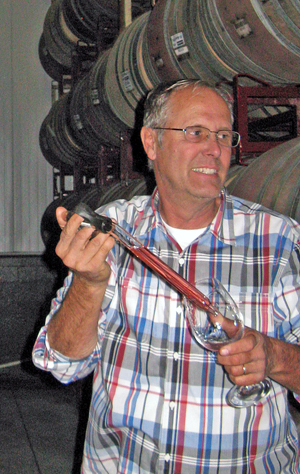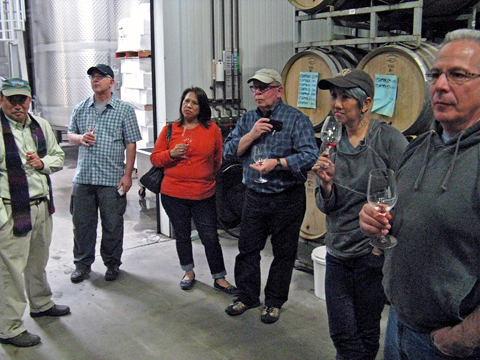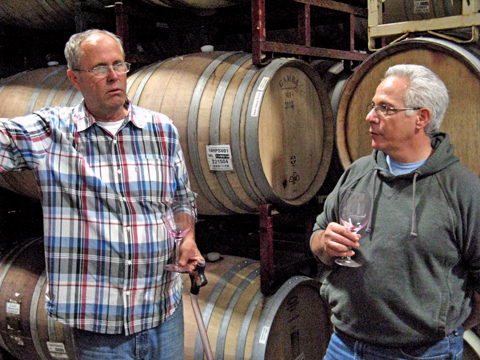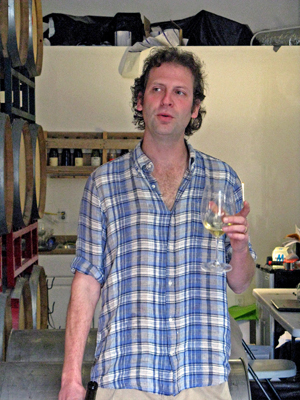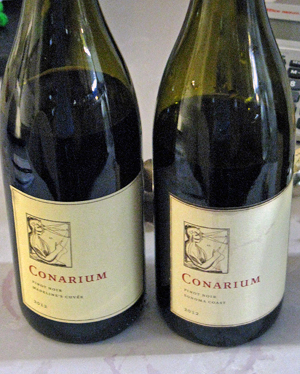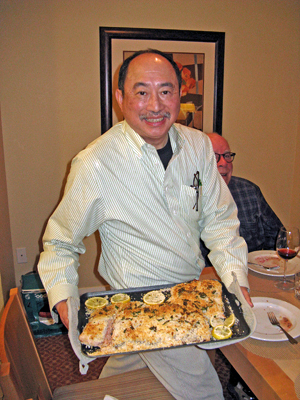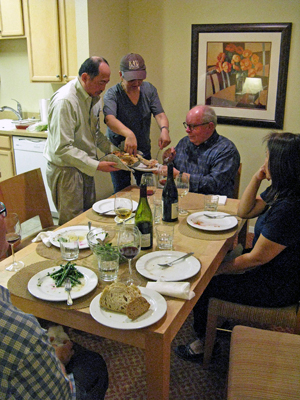Central Coast - January 2015 - Part 3
It had been a busy Friday and Saturday of wine-tasting along the Central Coast. Our group had traveled to the Paso Robles area and spent our Friday there, then continued our journey to Santa Barbara County on Saturday. Those first two days involved a good deal of driving in addition to enjoying some fine wines and meals, so it was nice to check into our timeshare units in Solvang – our home base for the next couple of days in Santa Barbara County wine country.
Since we ended up arriving fairly late at the timeshare on Saturday evening, we didn’t have a chance to do any grocery shopping for our Sunday breakfast, but we did have a few things on hand that we’d brought along with us. We weren’t planning to head out for any wine-tasting until about 10am, so we were able to relax together at one of the timeshare units, where we enjoyed some cranberry scones, Mary’s delicious banana bread, and some good coffee. Eventually we had to take off, and Eric joined Alan and me in my car for the day’s wine touring with Jane, Warren, and Mary in the other car. It was another gorgeous day, with sunny, warm weather. We had a very short drive to start off the day, just a couple of miles west to Buellton for our first Sunday tasting.
| Sunday
- January 18, 2015 |
Loring Wine Company / Cargasacchi Wines / Point Concepción Wines
Tasting Notes: Current Releases |
Loring 2013 Chardonnay, Rosella’s Vineyard, Santa Lucia Highlands. Medium-light yellow color, with stone fruit and pear, vanilla/oak, and some butter and spice notes. Rich, creamy texture, with a long smooth finish.
Point Concepción 2012 Pinot Grigio, “Marea Solia,” Santa Barbara County. Sourced from 30-year old vines at White Hill Vineyard, made in 100% stainless steel. Light straw color, this featured grapefruit, earth, and flowers on the nose. Medium-light weight with a fairly smooth mouthfeel and a clean finish.
Loring 2013 Pinot Noir, Rosella’s Vineyard, Santa Lucia Highlands. From Pisoni, 667, and 828 clones. Medium ruby color, showing ripe raspberry and black cherry fruit, spice, and earth aromas. Medium-bodied and lively on the palate, with moderate tannins.
Point Concepción 2012 Pinot Noir, “Salsipuedes,” Santa Barbara County. Sourced from Dierberg Vineyard, entirely destemmed, aged in 1- to 3-year old French oak barrels. Medium ruby color, with tea leaf and earth notes upfront and bright raspberry and plum fruit in support. Lively acidity in the mouth with fine tannins, nice.
Loring 2013 Pinot Noir, Durell Vineyard, Sonoma Coast. From 115 and 777 clones. Medium-light ruby color, displaying earth, herbs, and black cherry on the nose, plus touches of grilled meat and spice. Medium-weight with good acidity and structure, finishing with moderate tannins – nice now and should age well.
Cargasacchi 2011 Pinot Noir, Cargasacchi-Jalama Vineyard, Santa Barbara County. Tasted from a 375ml bottle. From 115, 115, Mount Eden, and “828” clones. Medium color, this was more earthy and spicy, along with cherry fruit and dried herbs. More structured on the palate, with tannins that still need more time to resolve – still needs more time but has promise.
Loring 2013 Pinot Noir, San Luis Obispo County. Sourced from Aubaine and Russell Family Vineyards, plus a little from Rancho La Viña, with 114, 115, 667, and 777 clones, aged in 33% new French oak. Medium ruby color, with more upfront raspberry fruit, spice, and vanilla/oak. A bit richer mouthfeel, with moderate tannins on the finish.
Point Concepción 2012 “Tranquillon,” Santa Barbara County. A proprietary red blend from 50% each Dierberg Vineyard Pinot Noir and Stolpman Vineyard Syrah, aged in 8% new French oak. Medium-dark purple, this showed darker fruits, herbs, and a touch of black pepper on the nose. Medium-full bodied with fairly grippy tannins.
Loring 2012 Mourvèdre, Russell Family Vineyard, Paso Robles. Medium purple color, with higher-toned ripe plum fruit, plus mocha, earth, and sweet oak. Big and structured, with a grippy tannic finish.
Point Concepción 2012 Merlot, “Czar & Rey,” Santa Barbara County. Sourced from Camp 4 Vineyard, aged in 15% new French oak. Medium color, featuring aromas of black cherry, plum, and lots of herbs, along with a background of vanilla/oak. Medium-bodied and lively, finishing with fairly big, chalky tannins.
Tasted at Hitching Post dinner on 1/19
Loring 2009 Brut Blanc de Blancs, California – Disgorged February 2014. Crown cap closure.
Loring 2009 Brut Rosé, California – Disgorged February 2014. Crown cap closure
Loring 2012 Grenache, Russell Family Vineyard, Paso Robles.
Loring 2012 Mourvèdre, Russell Family Vineyard, Paso Robles.
Loring 2009 “Divergence,” Paso Robles. 67% Cabernet Sauvignon (200% new American oak), 33% Mourvèdre (100% new French oak), sourced from Russell Family Vineyard.
Rasi 2013 Pinot Noir, “One,” Sta. Rita Hills. Sourced mainly from 115 clone at Cargasacchi and Clos Pepe vineyards, with a little 667 clone from Aubaine Vineyard, aged 10 months in 3- and 4-year old barrels, screwcap closure.
I didn’t take formal notes on these wines tasted at Hitching Post, but here are some general impressions. The Loring sparklers had subtle fruit but weren’t showing a lot of complexity, maybe in need of more time – the Brut Rosé was my favorite of the two. Of the Grenache and Mourvèdre, they were both big, ripe Paso-style Rhône-variety wines – I preferred the Mourvèdre. I somehow missed the “Divergence” at the Hitching Post dinner although I’ve tried it before – big, rich, borderline over-the-top but undeniably tasty. The Rasi Pinot struck me as having similarities with the Loring style, with a fruit-forward character and a just a hint of sweet oak, and had a nice elegance to it.
|
|
Our first stop of the day was at the tasting room of Loring Wine Company and Cargasacchi / Point Concepción Wines, located between the Hitching Post II restaurant and Buellton’s famed OstrichLand ranch. The tasting room opened in mid-2013, replacing the Loring tasting room that had been in the Lompoc Wine Ghetto.
Brian Loring and Peter Cargasacchi have each been key figures in Santa Barbara County wine over the past 15 years. I first met Brian in early 2001, when he was working on just the second commercial vintage of his Pinot Noirs. It was while Brian was working in a wine shop during his college days in Southern California that he was first drawn to Pinot Noir – Burgundy specifically. He enjoyed a few domestic Pinots, including those from Calera, Chalone, Williams Selyem, and Sanford, but the wine that really showed him what he hoped to find from California Pinot was a 1990 Cottonwood Canyon Pinot from Santa Maria Valley. He was able to work during crush at Cottonwood Canyon in 1997 with winemaker Norm Beko, and two years later Brian was producing his first commercial vintage of Loring Pinot. Brian and his sister Kimberly now run the winery.
Brian was one of the early proponents of the bigger and riper style of California Pinot that has been highly popular. He added a number of Chardonnays to his wine line-up starting in 2009, and he’s worked with a few other varieties here and there. Brian has also made two limited-production sparkling wines made by the traditional Méthode Champenoise, but with a California twist – the fruit is picked at the same time as for Brian’s still wines (much riper than for typical sparklers) and alcohol is removed from the wine (down to 11%) prior to starting secondary fermentation. But even with all the forays into other types of wine, the mainstay of the Loring label has always been Pinot Noir. There are several appellation Pinot blends plus nine current single-vineyard designate Pinots, with vineyard sources ranging from Santa Barbara to Sonoma County. All of the Loring Pinots are completely destemmed before fermentation, and all the wines have been bottled under screwcap since 2004.
The Cargasacchi and Point Concepción labels, launched in 2004, are the projects of Peter and Julia Cargasacchi. Brian Loring has been buying fruit from Peter nearly from the start, and I met Peter through Brian in late 2002. Peter is one of the best-known growers in the Sta. Rita Hills area. He planted his 12-acre Cargasacchi Vineyard in 1998 with the 115 clone of Pinot Noir on two different rootstocks. He began planting 16-acre Jalama Vineyard, just west of the Sta. Rita Hills AVA, in 1999 – it includes several Pinot clones along with a little Pinot Grigio. A third vineyard, Levante, was planted entirely to Pinot Noir in 2008 – it’s located on a hillside almost directly above Cargasacchi Vineyard in the western part of the Sta. Rita Hills appellation. The vineyard soils are ancient marine deposits that include calcareous and diatomaceous earth. Peter sells his fruit to a number of top producers including Brewer-Clifton, Hartley-Ostini Hitching Post, Ken Brown, Siduri, Loring, Bonaccorsi, and Babcock among others.
Peter makes his Cargasacchi wines entirely from estate fruit. There are two single-vineyard Pinots produced under the Cargasacchi label, one from Cargasacchi Vineyard and one from Cargasacchi-Jalama Vineyard. For the past few years, the Cargasacchi-Jalama bottling has been in a 375-ml bottle (with a screwcap closure) rather than a typical 750-ml one in order to help avoid confusion between the two vineyard-designates. A third wine under the Cargasacchi label is the “Invincible Sun” late-harvest Pinot Grigio sourced from Cargasacchi-Jalama Vineyard. The Point Concepción wines are made for earlier enjoyment, and are from purchased fruit. The wine line-up includes “Caponera” Chardonnay, Pinot Grigio (including one bottling – “Celestina” – left on the skins for a few days before pressing), “Salsipuedes” Pinot Noir, a Pinot-Syrah blend called “Tranquillon,” and “Czar & Rey” Merlot.
We arrived at the tasting room not long after opening time, so it was not surprising that we were the first group of tasters there. It’s a very warm, homey space, and Steve greeted us from behind the tasting bar. We were able to taste ten wines with Steve – five Loring bottlings and five from Cargasacchi and Point Concepción. Steve poured the wines in pairs for us so we could compare them, and even though it was not always an apples-to-apples comparison (the first pair was Chardonnay and Pinot Grigio, for example), it was an interesting way to taste all the wines.
There’s a postscript to our tasting room visit – I’d originally thought that both Brian and Peter were going to be out of town the weekend of our visit (I wasn’t trying to avoid them, really!) but it turned out that Brian was around. Although he wasn’t able to meet us for our tasting, he did join us for dinner on Monday evening at the Hitching Post II in Buellton, and he brought along some of his wines for us to try then, including his two sparkling wines. And he also brought along his assistant winemaker, Rachel Silkowski, who had recently released her first wine under her new Rasi label (pronounced “racy”). Rachel is off to a fine start, with a single barrel of Pinot Noir sourced mostly from Cargasacchi and Clos Pepe vineyards along with a little from Aubaine Vineyard (near Nipomo in southern San Luis Obispo County). Her wine labels are cool, too – each of the 300 bottles features a unique wine splotch on the label. Although I didn’t jot down any detailed tasting notes for the wines we enjoyed at that dinner, I’ve included them in the “Tasting Notes” box and added some general impressions about them.
Stopping in at the Loring / Cargasacchi / Point Concepción tasting room was a fine way to start our day. It’s a great location and a fun, informal space, right down to the decorative stone and tile floor inside the entryway with an old manhole cover as its centerpiece! Pairing up the wines for us to taste there set up some interesting comparisons, and there were a number of intriguing bottlings for us to try. Favorites included the Loring Durell Vineyard Pinot Noir and the Point Concepción “Marea Solia” Pinot Grigio and “Salsipuedes” Pinot Noir, and the Loring Rosella’s Vineyard Chardonnay and Cargasacchi Cargasacchi-Jalama Vineyard Pinot were also noteworthy. While Brian’s wines have shown remarkable consistency through many vintages, I feel that his more recent Pinots have displayed more structure for aging than his earlier wines did. Peter’s wines have been a bit more variable than Brian’s over the years, but I thought that his latest set of releases showed particularly well. The Loring / Cargasacchi / Point Concepción tasting room is an easy stop to make while in Santa Barbara County wine country.
Tierra y Vino
Tasting Notes: Current Releases and Pre-releases |
caren 2012 Albariño, La Presa Vineyard, Santa Barbara County. Made in 80% stainless steel and 20% neutral oak. Light straw color, with intense apple and orangepeel aromas, plus a hint of fresh herbs. Medium-light bodied, this finished with a slightly chalky mineral note.
Ibarra 2012 Roussanne, La Presa Vineyard, Santa Barbara County. Made entirely in stainless steel. Light yellow color, this displayed pear and stone fruit, flowers, earth, and wet stones on the nose. Medium-bodied with a more viscous texture but lively acidity, and a long, tasty finish, nice.
Ibarra 2012 Grenache, La Presa Vineyard, Santa Barbara County (pre-release). 100% Noir clone Grenache, aged in about 30% new French oak. Medium-light color, showing raspberry and strawberry, lots of spice, and a touch of sweet oak. Medium weight on the palate, this finished with moderately grippy tannins.
Ibarra 2012 “Tres Uvas,” Santa Barbara County (pre-release). 60% Grenache, 25% Syrah, 15% Petite Sirah, aged in about 30% new oak. Medium purple color, with plum, spice, and black pepper aromas, along with a bit of mocha. More structured in the mouth, with chewy tannins on the finish.
Ibarra 2010 Petite Sirah, La Presa Vineyard, Santa Barbara County. Dark color, featuring higher-toned black fruits, earth, black pepper, and a savory/meaty component. Bold and rich but with loads of acidity, finishing with big but fairly refined tannins, nice.
|
|
Our next winery was a completely new one to me – in fact I’d never heard of it until a few weeks before our Central Coast trip. Called Tierra y Vino, it was recommended by a friend, Rosemary, who’s come along on a wine trip with our group once or twice and who knows the winery owners. Tierra y Vino proprietors Andres Ibarra and Caren Rideau actually have two wine labels, caren and Ibarra. Since Tierra y Vino does not currently have a tasting room, Caren suggested tasting their wines at La Presa Vineyard, which Andres manages. The vineyard is on the outskirts of Solvang, but as Caren thought it might be a little tough for us to find, she offered to meet us at a bank parking lot near one of the major intersections in the area so we could follow her from there. We all pulled into the parking lot within about a minute of one another, and Caren got out to introduce herself to our group before heading out again, with the rest of us following behind.
The route to La Presa Vineyard wasn’t very long, but there were a few twists and turns that might have been tricky even with GPS, so it was good that we were able to follow Caren’s car. We arrived at a house and walked out to a patio that offered a beautiful overview of the vineyard. A couple of other people, David and Amy, were already there, and Eric recognized Amy right away – she’s a TV news reporter in Los Angeles (Amy Powell). Caren told us that they’re part of the family, and we soon learned several other interesting family ties. Both Caren and Andres have last names that should be familiar to those who know the Santa Ynez Valley wine region. Caren is the goddaughter of Rideau Vineyard’s owner Iris Rideau, while Andres’ uncle is the Ibarra of Ibarra-Young Vineyard, the fruit source for several Qupé wines among others.
Andres is originally from Mexico, and came with his mother and siblings to California in 1975 to join his father, who worked on a horse ranch in Santa Ynez Valley. In 1980, Andres found a job in the vineyards of Brander Winery, and before long Fred Brander had him working in the cellar there when needed, which started Andres’ path toward becoming a winemaker. By 1985, he was offered a position managing La Presa Vineyard, which he still continues to do. He got his first winemaking job in 1989 at Santa Ynez Winery, and has made wine for several other local producers in the years since, including Fess Parker and Rideau (where he met Caren). Andres now makes wine for four other labels in addition to the Tierra y Vino wines.
|
| Jane, Caren Rideau, and Amy Powell |
Caren’s background is as a residential designer, and in 1989 she founded her highly-respected design business, Kitchen Design Group. During her travels though Europe to learn more about architecture there, she also learned about wine. She also developed winemaking experience at Rideau Vineyard. Caren still works at her design business in Pacific Palisades during the week but spends weekends with Andres in Santa Ynez Valley.
We sat around a couple of round wood tables on the patio, while Andres told us about La Presa Vineyard. The 40-acre vineyard was first planted in 1973 to Cabernet Sauvignon, Chardonnay, and a little Cab Franc and Merlot. It originally had the wider 12’x7’ vine spacing typical of that time but more recent plantings have replaced that with 8’x5’ spacing. Varieties now grown at La Presa include Riesling, Viognier, Roussanne, Marsanne, Grenache Blanc, Chardonnay, Sauvignon Blanc, Albariño, Grenache, Syrah, Tempranillo, and Petite Sirah. La Presa fruit is sold to 18-20 other producers, including D’Alfonso-Curran, Storm, Carhartt, Jalama, Consilience, and Kaena, among others. Andres noted that the vintners have a good deal of say into how their particular vineyard blocks are farmed for them.
Andres and Caren began pouring us tastes of their wines, all of which came from fruit farmed at La Presa Vineyard. We started with the 2012 caren Albariño, the inaugural vintage of that wine, which was made mostly in stainless steel along with a little neutral oak. Caren told us that Andres planted Albariño and Tempranillo at La Presa for her around 2006. We moved on to some Ibarra wines – the first releases under that label came from the 2010 vintage. The 2012 Roussanne was made entirely in stainless steel – it’s a variety that is more typically barrel-fermented and aged but the Ibarra rendition was quite distinctive and one of the tasting’s standout wines. Next was 2012 Grenache, and Andres said that he farms the fruit for it to get just one cluster per shoot, an unusually low crop load for that variety. The Ibarra Grenache will not necessarily be 100% varietal in every vintage, though it was for 2012. The 2012 “Tres Uvas,” like the Grenache, was bottled in December and should be released in February. As the name of the wine would imply, it’s a blend of three varieties – Grenache, Syrah, and Petite Sirah. We finished with a 2010 Petite Sirah. All of the reds are destemmed prior to fermentation, and they are aged in mostly French oak along with some Hungarian barrels, and a little American oak only on the Petite Sirah.
As we were relaxing around the tables with our wine, we briefly talked about the effort to create a new Los Olivos District AVA, which would include La Presa Vineyard within its proposed boundaries. Fred Brander has been the driving force behind the proposed AVA, which is currently under consideration by the TTB. The proposed appellation would be entirely within the existing Santa Ynez Valley AVA, which was established in 1983, and would lie between Ballard Canyon on the west and Happy Canyon on the east. A warm but not hot region, it’s known mainly for growing Bordeaux and Rhône grapes, though it has some Italian and Spanish varieties as well. The proposed AVA includes over 50 vineyards and more than a dozen wineries.
Tierra y Vino will be releasing three new wines in March – Ibarra 2012 La Presa Vineyard Chardonnay, Ibarra 2013 La Presa Vineyard Sauvignon Blanca, and caren 2014 Santa Barbara County Rosé. In addition to the wines we tasted with Caren and Andres and their new releases, the winery produces a Tempranillo and a Port-style dessert wine called “Cielo.” The wines are made at the Kalyra Winery facility in Santa Ynez, and current annual production is around 650 cases.
Considering that our visit with Caren and Andres of Tierra y Vino at La Presa Vineyard was late addition to our wine touring itinerary, and was a producer that was entirely new to me, this was one of the most memorable stops during our Santa Barbara wine country travels. Caren and Andres were wonderful hosts, and it’s hard to beat a beautiful setting overlooking a vineyard for tasting wine. But beyond the setting, the wines were all very good, with the Ibarra Roussanne and Petite Sirah being particular favorites, with the caren Albariño close behind. Discovering solid wines from a newer and under-the-radar producer is a good feeling – I’m glad that we were able to taste with Caren and Andres, and look forward to visiting them again in the future.
It was time for lunch by the time we finished our Tierra y Vino tasting, and we’d already arranged to meet our friend John Tomasso at a fairly new spot called Industrial Eats (it’s on Industrial Way in Buellton). And since we were scheduled to meet nearby with Hartley-Ostini Hitching Post’s Gray Hartley for our next wine visit just down the street, we invited him to join us for lunch too. Industrial Eats has been open only about a year, but the word has already spread about it.
Set in an airy room with an open kitchen – featuring two wood-fired ovens – it’s a got a fun, informal vibe, right down to the steer poking its head out the front door. Stepping up to order, we read from daily menus written on rolls of butcher paper on the kitchen wall behind the counter, then found seats at the large communal table in the center of the space. The menu features sandwiches, pizza, and “not pizza,” and everything was delicious – each of us ordered something different. I had the best tuna melt I’ve ever eaten, with Italian tuna, capers, gruyere, and artichokes, served with an arugula salad. There’s also a butcher shop case with some very tasty-looking cuts of meat to take home. I’ll definitely be back.
Eric excused himself from the table just as we were finishing our lunch, as he was meeting local photographer and vineyard tour guide Lee Tomkow to pick up some wine from him – Lee also does marketing work for Ethan Lindquist’s No Limit wine label. Before walking back to our cars, I took a quick peek at the new Alma Rosa tasting room next door – they’ve moved from their old spot along Santa Rosa Road. We didn’t have far to go to our next destination, down at the end of the street.
Hartley-Ostini Hitching Post Winery
Tasting Notes: Barrel Samples |
Hitching Post 2014 Valdiguié Rosé, French Camp Vineyard, Paso Robles (barrel sample). From about 40-year old vines, fermented in stainless steel tank and neutral oak. Very light pink color, displaying bright and fresh tropical fruit aromas. Medium-light bodied with juicy acidity and a clean finish.
Hitching Post 2013 Pinot Noir, Bien Nacido Vineyard, Santa Maria Valley (barrel sample). From 777 clone, younger vines. Medium-light ruby color, this showed bright cherry, spice, tea leaf, and a touch of sweet oak. Medium-light weight with fairly mild tannins.
Hitching Post 2013 Pinot Noir, Bien Nacido Vineyard, Santa Maria Valley (barrel sample). From Pommard clone, older vines. Medium-light color, with more subdued earthy and herbal aromas, plus black cherry and plum fruit. A bit more body on the palate with fine tannins.
Hitching Post 2013 Pinot Noir, Pence Ranch, Santa Barbara County (barrel sample). Medium-light ruby, with riper red cherry and raspberry fruit, earth, and spice on the nose. Lively mouthfeel and finish.
Hitching Post 2013 Pinot Noir, Fiddlestix Vineyard, Sta. Rita Hills (barrel sample). From first pick. Medium-light color, this was less fruit-forward, with earth, tea leaf, and subtle black cherry aromas. Medium-bodied with plenty of acidity and slightly grippy tannins.
Hitching Post 2013 Pinot Noir, Fiddlestix Vineyard, Sta. Rita Hills (barrel sample). From second pick, Hungarian oak barrel. Medium-light color, showing riper black cherry and plum, spice, and touches of smoke and sweet oak. Slightly bigger mouthfeel with moderate tannins.
Hitching Post 2014 Pinot Noir, Fiddlestix Vineyard, Sta. Rita Hills (barrel sample). Medium-light ruby color, with more upfront and bright dark berry fruit, earth, and dried herbs. Medium weight on the palate with a fairly smooth finish.
Hitching Post 2014 Pinot Noir, Quinta del Mar Vineyard, San Luis Obispo County (barrel sample). From 115 clone. Medium ruby color, this featured red fruits, savory herbs, earth and a dash of vanilla/oak. Medium-bodied with fine acidity and structure on the palate, finishing with a stony mineral note, very promising young Pinot.
Hitching Post 2014 Pinot Noir, Rio Vista Vineyard, Sta. Rita Hills (barrel sample). Medium-light color, this had riper black cherry and plum aromas along with spice and a touch of sweet oak. Lively acidity with moderate tannins on the finish.
Hitching Post 2014 Syrah, Alisos Vineyard, Santa Barbara County (barrel sample). Dark purple color, displaying meaty and peppery aromas plus higher-toned dark fruits and chocolate. Big and structured, finishing with fairly grippy tannins.
Hitching Post 2014 Valdiguié, French Camp Vineyard, Paso Robles (barrel sample). From about 40-year old vines. Medium ruby-purple, with raspberry, black pepper, and dried herbs on the nose. Medium weight with bright acidity and chalky tannins.
Hitching Post 2014 Sangiovese, Don Petroni Vineyard, Happy Canyon of Santa Barbara (barrel sample). Will go into the “La Tarantella” Sangiovese bottling. Medium color, this showed bright and ripe cherry fruit, spice, and a hint of wet stone. Medium-bodied with moderate tannin and a slightly tangy finish.
|
|
Most of our group knew where the Terravant Wine Company custom crush facility was located, at the end of Buellton’s Industrial Way, but we still followed Gray Hartley down the street. It wasn’t tough to keep an eye on his car – a turquoise-colored 1951 Ford Country Squire woodie station wagon. Gray told us it’s the same model as the first car he owned when he was 19. We spent a few minutes checking it out in the Terravant parking lot, and Gray even opened up the hood so we could take a look – those old car engines sure look a lot simpler than the ones today!
|
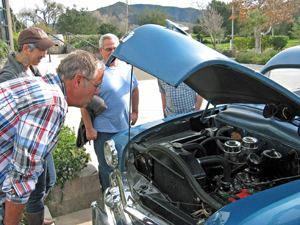 |
Gray is one of the partners of Hartley-Ostini Hitching Post Winery, the other being Frank Ostini. Gray and Frank come from very different backgrounds, but they’ve been good friends for many years. Frank is the owner and chef of Buellton’s famed Hitching Post II restaurant, while Gray was a commercial salmon fisherman in Alaska for over 25 years. I’d met both Gray and Frank a number of years ago, as Hitching Post II has been a regular dining spot for me since the mid-1990s whenever I’ve come to Santa Barbara County to go wine-tasting. Eric and I even helped out Gray and Frank at one of the Hitching Post wine-bottling sessions in early 2005.
Back in late 2005, at a memorable dinner at Hitching Post II with John Tomasso, Peter Cargasacchi, and my friend Danny, Gray spotted us after he’d finished his own dinner and joined us at our table. He and Peter were both in story-telling moods (aided by the numerous bottles of wine on the table, no doubt), and John, Danny, and I were spellbound as we listened to them spinning yarns – and believe it or not, Gray bested Peter on that night! The story of the evening was the one of how Gray first met Frank at the original Hitching Post restaurant in Casmalia, owned by Frank’s family. Since my own memory of the details is a little foggy, and Gray is a far better storyteller than I am in any case, I asked him whether he’d mind if I included his own account of the events, so here it is:
“I had returned from a three-month 1976 salmon season in Alaska and found a little fixer-upper to buy and turn into a rental in Casmalia, right behind the original Hitching Post. After a few days of remodeling, that intoxicating BBQ smell drew me in for a Sunday dinner. While enjoying the Sunday night chicken special, I noticed a couple who were fidgeting with their coats and looking around for the whereabouts of the hostess. I suspected they might try to dine and dash so I alerted the hostess, who went back to the kitchen to tell Frank. Now mind you that Frank and I had not yet met. The couple scurried out the front door, I followed them out and wrote their license plate number on my hand and then shared it with Frank moments later. The Hitching Post lost $50 that night but the two of us have remained friends ever since.”
They’d both developed an interest in wine, and when Frank called Gray in 1979 to see if he wanted to help make a barrel of wine – with the idea that one day it might be something they could bottle for the restaurant – they were on their way. They made that first barrel in Frank’s garage, and since then they’ve made their wine at Byron, Au Bon Climat / Qupé, Central Coast Wine Services, and since 2008 at Terravant. Many of the early wines were made by noted Santa Barbara winemaker Lane Tanner, who was married to Frank at the time.
Gray and Frank made their first Pinot Noir in 1981, and it’s the variety for which they’ve become famous. They currently produce five single-vineyard designate Pinots, from Bien Nacido, Julia’s, Cargasacchi, Rio Vista, and Sanford and Benedict vineyards, the first two in Santa Maria Valley and the last three in Sta. Rita Hills. Additional Pinot bottlings include “Hometown”, “Cork Dancer”, “St. Rita’s Earth”, “Highliner”, and “Perfect Set.” The last two deserve special note. “Perfect Set” is a barrel selection from Fiddlestix Vineyard in Sta. Rita Hills, and is only produced from the best vintages there – just a few have been released to date. “Highliner” is Hitching Post’s top-of-the-line bottling, a barrel selection of their best lots. The name is a tribute to Gray’s years as a fisherman – “highliner” is the industry term for the most elite commercial fishermen. Both the Hitching Post restaurant and wine label benefited from their exposure in the 2004 movie Sideways – some much-deserved attention after many years of hard work.
In addition to Pinot, Hitching Post currently makes several other wines, including a Rosé called “Pinks” that’s made from Pinot Noir and Valdiguié, “Big Circle” Syrah, red blends called “Generation Red” and “Four Top”, a Sangiovese called “La Tarantella,” and – ironically, considering Sideways – a Merlot.
Gray led us upstairs and through the Avant restaurant that’s part of the Terravant facility, which was completed seven years ago. We looked down from windows into the production portion of the building, where we could see the tall stacks of Hitching Post barrels reaching up to our level. Gray said that when they first considered moving into Terravant, they were told that winery clients would not be allowed to do any work there – the winemaking was all to be done by Terravant staff according to each client’s specifications. Gray and Frank would have none of it and insisted that they be able to do their own winemaking there, and Terravant relented. There are now about 25 smaller clients at the facility plus a few larger ones. The staff there is around 20 people year-round, with up to about 40 during crush. The equipment belongs to Terravant and is used for all of their clients – they even have their own bottling line.
Gray took us on a short tour through the facility. We looked down from a catwalk to a conveyor system for incoming fruit that directs it through chutes to a destemmer or straight to a press – there are smaller basket presses available as well. Gray pointed out a heat exchanger that cools incoming fruit – they’ve learned that this is more efficient than chilling it with glycol. We also looked from the catwalk into large open-top temperature-controlled fermentation tanks (7-, 12-, and 20-ton capacity) that are custom double-decker design, with a fermentation chamber on top and a separate chamber for press wine to settle on the bottom, where it can then be barreled down. All of the Hitching Post wines except the Rosé are inoculated with Assmannhausen yeast. There is pneumatic punchdown equipment for the tanks, and Gray said that he likes to use the largest tanks they can for their lots. He told us that he likes to heat fermentation temperatures up to around 90 degrees and then just let them continue naturally from that point, and that he can track tank temperatures from a remote computer. As you see more and more in recently-built wineries, there has been a lot of effort to make everything environmentally friendly. Water is collected and treated, then percolated back into the soil, and pomace from pressing the wines is used for compost and cattle feed.
We proceeded through the facility and into the Hitching Post barrel room. They have about 1,000 barrels there, with stacks up to six high. After searching for a short time to find his wine thief – Gray said that other people using it usually put it back in the same place, but not always – he began pulling barrel samples for us to taste. We started with Valdiguié for the “Pinks” Rosé, made from 40-year old vines at French Camp Vineyard in Paso Robles, farmed by the Miller family of Bien Nacido fame. The final Rosé blend will include the Valdiguié – fermented in stainless steel and neutral oak – plus saignée from Pinot Noir.
Moving on to Pinot Noir samples, we worked our way through some barrels of 2013 wines and then to 2014s. Gray told us that they can bring in as many as 30 different lots of Pinot each vintage. Most Pinots get only a small percentage of new oak – the basic “Hometown” Pinot is all neutral oak, “Cork Dancer” is about 10% new oak, and most others are between 20-30% new oak. We compared 2013 Bien Nacido Vineyard Pinot samples from younger and older vines (and different clones), and compared wines from an earlier and a later pick from Fiddlestix Vineyard. We tasted a sample of 2014 Pinot from Quinta del Mar Vineyard from a cool site near Nipomo – this was a terrific young wine, and Gray said that they plan to bottle it as a single-vineyard designate. He mentioned that all of their 2014 wines are already finished with malolactic fermentation – it went very quickly in this latest vintage. We finished up with samples of 2014 Syrah, Valdiguié, and Sangiovese.
As we were wrapping up our visit, Gray told us that his son Weston – who, like his father was, is a commercial salmon fisherman in Alaska during the summer months – was just getting ready to leave for Australia to work there during crush at Hewitson Winery in Barossa Valley. Weston also works for Kunin and Pali wineries in Santa Barbara County during the fall. Gray’s daughter Emily had also worked with Pali in the past – her husband Aaron Walker is the Pali winemaker. Weston worked with Gray and Frank on the Hitching Post wines for three years when they produced them at Central Coast Wine Services, and he may become a part of the Hitching Post wine business in the future. It’s clear that Gray is excited about how Weston is taking advantage of the same kinds of opportunities that he did when he was that age.
|
| Gray Hartley, John Tomasso |
This was my first time touring the Terravant custom crush facility, and Gray was the perfect person to take us through the building and then lead us on a tasting of Hitching Post barrel samples. He’s soft-spoken but still barely able to hide the excitement and fun he continues to have in making the Hitching Post wines. And while many vintners have a great sense of humor, Gray’s ranks right up there with the best. Favorite barrel samples we tasted included the 2014 Valdeguié Rosé, 2014 Quinta del Mar Pinot Noir, and the component parts of the 2013 Bien Nacido and Fiddlestix Pinots, each of which should blend together nicely.
Even though the Hitching Post label increased production to meet the demand of post-Sideways wine consumers, they’re still making some very fine Santa Barbara County wines, especially their Pinot Noirs. They’ve stuck with their strength of a “middle-of-the-road” style – they’ve never been among the biggest and ripest Pinots but not especially light and lean either. And the wines have maintained a good track record for aging well too. Sometimes we lose sight of tried-and-true producers in our rush to discover the next big thing, but Hartley-Ostini Hitching Post is a label we shouldn’t neglect – Gray and Frank continue to make some delicious wines.
Conarium Wines
Tasting Notes: Barrel Samples & Current Releases |
Conarium 2013 Chardonnay, Clos Pepe Vineyard, Sta. Rita Hills (barrel sample). From clone 76. Light yellow color, with leesy citrus fruit and herbs on the nose. Medium-bodied, with a moderately creamy texture, lots of acidity, and a lively finish.
Conarium 2014 Chardonnay, Clos Pepe Vineyard, Sta. Rita Hills (barrel sample). From clone 76, made in about 65% neutral oak and 35% stainless steel. Light yellow-straw color, featuring brighter and fresher pear and stone fruit aromas than the previous wine, along with spice and a floral note. Medium-light weight with a lively texture and a stony mineral note on the finish, this should develop nicely.
Conarium 2014 Pinot Noir, Fiddlestix Vineyard, Sta. Rita Hills (barrel sample). From 115 clone, about 75% whole-cluster fermentation. Medium-light ruby color, this showed raspberry, earth, tea leaf, and flowers on the nose. Medium-bodied with moderately chalky tannins.
Conarium 2014 Pinot Noir, Fiddlestix Vineyard, Sta. Rita Hills (barrel sample). From 115 clone, entirely destemmed. Medium-light color, with more upfront ripe raspberry fruit and spice aromas, plus a touch of earth. Medium weight, finishing with more refined tannins.
Conarium 2012 Pinot Noir, “Madeline’s Cuvée,” Santa Maria Valley. From older vines, 50% whole-cluster fermentation, aged for 16 months in about 70% new French oak. Medium-light ruby color, displaying tea leaf, cherry, spice, a hint of tomato, and a background of sweet oak. Medium-bodied with good structure and fine tannins, nice.
Conarium 2012 Pinot Noir, Sonoma Coast. Sourced from Black Knight Vineyard in the Petaluma Gap, about 25% whole-cluster fermentation. Lighter garnet color, with cherry, rhubarb, herbs, and earth on the nose. Medium weight with a stony mineral note on the finish.
Conarium 2012 Chardonnay, Sonoma Coast. Made in about 80% neutral oak and 20% stainless steel. Light yellow-straw color, this showed pear, lees, earth, and floral aromas. Medium-bodied with a vibrant texture and lively finish, nice.
Conarium 2011 Chardonnay, Clos Pepe Vineyard, Sta. Rita Hills. Made in 50% each neutral oak and stainless steel. Light yellow-straw, with higher-toned ripe pear and stone fruit, plus touches of spice and lees. A bit richer on the palate than the previous wine, with a smoother finish.
|
|
For our last wine visit of the day, we drove from Buellton west along Highway 246 to Lompoc. Heading into the collection of industrial metal buildings on the southeast edge of town that’s become known as the Lompoc Wine Ghetto, we navigated through a maze of look-alike structures and soon found our destination, Conarium Wines. I wanted to visit Conarium since I’d met partner / winemaker Dan Green a few years earlier when he was working for Ed Kurtzman at the Roar facility in San Francisco. Conarium makes Chardonnay and Pinot Noir from vineyard sources in both Santa Barbara and Sonoma counties. Dan welcomed us inside, and he told us a little about himself.
Dan is originally from the Washington DC area, where he had more experience drinking wines from France than from California, becoming a particular fan of white Burgundies. He had thought at one time about opening a wine bar, but realized that what he really wanted to do was to make his own wine. After studying enology at Cal State Fresno, he worked for Wes Hagen at Clos Pepe Vineyard before heading north to work with Ed Kurtzman. Returning to Santa Barbara County, he worked with Norm Yost at Flying Goat Cellars. Dan’s partner in Conarium is Greg Nelson, who also went to Cal State Fresno, where he met Dan in the enology program. A scientist by trade, Greg has a PhD in biology. He heads up the Conarium winemaking in Sonoma (and also does enology work for Sonoma wineries including Ramey Wine Cellars) while Dan leads the Santa Barbara winemaking effort. They’re planning to consolidate all the production in Lompoc beginning in 2016.
Currently, about 80% of the wine is made in Lompoc and 20% in Sonoma. Conarium shares its space in the Lompoc Wine Ghetto with Lindley Wines, and Jake Lindley joined us for a moment or two as we were visiting with Dan. Dan showed us where he’s planning to build out a tasting room in the space, and told us of the difficulties in dealing with the local building department – as an architect myself, I feel his pain!
The Conarium name comes from a structure in the brain that helps control our interaction with sunlight during the day and through the seasons, tying in with the delicate balance of grapevines interacting with the seasons in each vintage. The conarium has been called the mind’s eye by some, and related to the mystical “third eye” – the image on the labels is taken from a 17th-century woodcut depicting how the body and soul interact through the conarium. The connecting idea in terms of winemaking is one of balance. Dan and Greg look to source fruit from cool-climate vineyards and from older vines where possible, using minimal intervention in the winery.
Conarium is a very new winery, with the first release coming from the 2011 vintage – a Chardonnay from Clos Pepe Vineyard and a Pinot Noir from Huber Vineyard, both in Sta. Rita Hills. Other vineyard sources have included Fiddlestix in Sta. Rita Hills and Black Knight in the Sonoma Coast’s Petaluma Gap.
Chardonnay is made in a combination of stainless steel and mostly older oak – very little if any new oak is used. The Chardonnays go through native yeast and full malolactic fermentation, with fermentation temperatures usually no higher than about 70 degrees. Chardonnay is aged on the lees (stirred about once a month) for 16-18 months in barrel, mainly François Frères and Damy, with no new oak. For Pinot, some whole clusters are used in fermentation, anywhere from about 30-75%. Cold soaks last from two to six days, and both foot-treading and manual punchdowns are done during the native fermentation. The Pinots have been fermented in macrobins, but Dan said that he may look at using larger wood fermenters in the future. He talked about using the “pied de cuvée” method to start fermentation – using the native yeast from an early pick to start fermentation in later picks. Pinot fermentation temperatures are greater than with the Chardonnays, going up to around 90 degrees with a goal of increasing structure and texture and dialing back a bit on the primary fruit. Pinots are aged for about 24 months in up to 30% new French oak, mostly Sirugue and Remond.
Dan led us through a tasting of both barrel samples and bottled wines, starting with Clos Pepe Vineyard Chardonnay barrels from 2013 and 2014. The 2013 Clos Pepe Chard, made from clone 76, will be bottled soon. Dan told us that the 2014 Clos Pepe Chardonnay came from a different part of the vineyard than the 2013. We went on to compare barrel samples of 2014 Fiddlestix Pinot, one with mostly whole-cluster fermentation and one entirely destemmed. The final blend of this wine will have 25-30% new oak. Dan usually racks the Pinots after about 14 months in barrel and then blends the wine back along with the lees, in an effort to enhance the texture. In general, he’s not looking for overt fruit in the wines, aiming more for earthy character and texture.
We moved on to some bottled wines, beginning with the 2012 “Madeline’s Cuvée.” Dan told us that this wine will not necessarily be from the same source each year – in 2012 it came from one of the oldest Pinot sites in Santa Maria Valley but it may be from a Sta. Rita Hills source in 2013. Conarium produces both single-vineyard designate wines and appellation bottlings, and the next two we tried were the 2012 Sonoma Coast Pinot Noir and Chardonnay. We finished up with the 2011 Clos Pepe Vineyard Chardonnay. Dan said that this was fermented in 50% each stainless steel and oak – he had originally planned to bottle each component separately but liked the blend of the two better.
It was fun to re-connect with Dan and to see what he’s been doing with his most recent wines. I was on the crew that helped bottle the 2012 Conarium Chardonnay and Pinot Noir, and one of our bottling day traditions has been to open a couple of bagged “mystery wines” at lunch, and see if people can guess what they are. Knowing that Dan had worked with Wes Hagen, I brought an older Clos Pepe Pinot Noir as a mystery wine, thinking he might have tasted some older vintages there. Although I recall that everyone easily recognized that it was a Pinot and a couple of people thought it could be from Santa Barbara County, I managed to fool Dan on that wine – he never guessed that it might be a Clos Pepe!
Tasting barrel samples can be a good way to learn about the results of various approaches to making a wine, and this was no exception. The whole-cluster and destemmed components of the 2014 Fiddlestix Pinot presented distinctively different components of what should become quite a nice wine. As you might expect with a newer winery such as Conarium, the initial vintages show some variation, and as Dan and Greg work more with selected growers and fine-tune their winemaking, I’m sure we’ll see more consistency in the future, especially once the production is consolidated in the Lompoc facility. Favorite wines included the 2012 Sonoma Coast Chardonnay and “Madeline’s Cuvée” Pinot Noir, which displayed classic Santa Maria Valley Pinot character. I’m looking forward to following Conarium and seeing how their wines develop in the following years.
The main reason we’d switched our dinner at Ballard Inn from Sunday to Saturday was that we’d decided to make dinner at the timeshare on Sunday. After driving back from Lompoc, we stopped in at the New Frontiers Market in Solvang and El Rancho Market in Santa Ynez to pick up supplies. Jane and Mary led the food prep team, and we had panko-crusted salmon, green beans, roasted beets, bread, and salad, along with several of the wines we’d brought along with us.
After cleanup and a short TV break, we broke open the box with my “Wine Wars” wine trivia game. It took awhile, but Warren and Alan were the winning team on this occasion. They kept coming up with the right rolls of the dice – something fishy going on, I say!
|


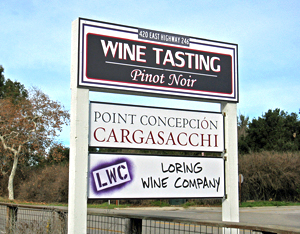
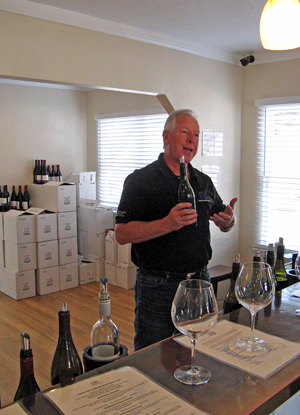
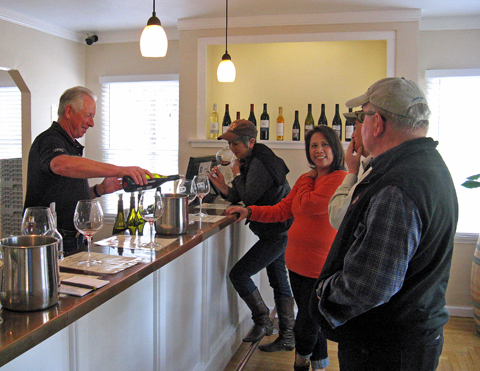
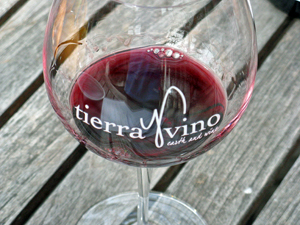
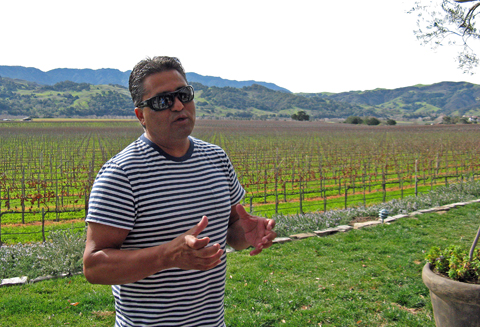
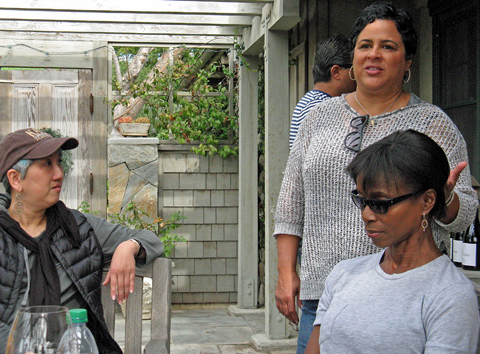

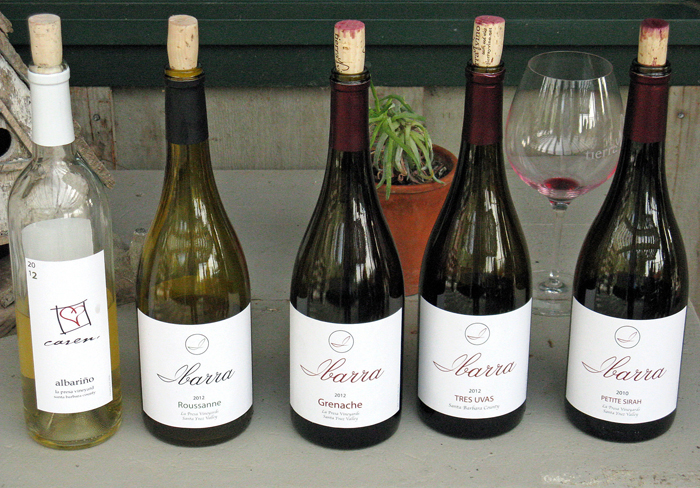
.jpg)
.jpg)



